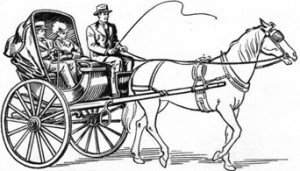In the 1890s, the primary mode of transportation was still horse-drawn carriage. Here you can find information on the kinds of carriages mentioned within the Alienist books in addition to other forms of transport that the characters use.
Transport in the Books
Canadian Calash
Within the books, this is Dr. Kreizler’s primary mode of transportation. His is black and is generally pulled by his black gelding, Frederick. A canadian calash was a light carriage pulled by a single horse. It was two-wheeled, as opposed to the regular calash which was four-wheeled, and had a folding hood.1 A calash similiar to Dr. Kreizler’s is shown to the left.
Barouche
Dr. Kreizler also owns a barouche for when he needs to transport more than two passengers or when he has a formal occassion to attend. His is burgundy with black trim and is pulled by his black gelding, Frederick, and his brown mare, Gwendolyn. The barouche was a large, ornate four-wheeled carriage and seated four passengers. It had two interior seats that faced each other and a seat at the front for the driver. Due to the fact that most barouche carriages only had one folding hood, and therefore only protected two passengers in the event of rain, it was slightly less popular during the 19th century than the landau which had two folding hoods.1
Brougham
Within The Alienist, a common sight is Paul Kelly’s brougham. A brougham was an elegant coach which was fully enclosed (as opposed to the barouche). They were pulled by one or two horses and the driver sat on the outside of the vehicle at the front. Paul Kelly’s brougham is a four-passenger model, however two-passenger models were also in use. Brougham’s were highly desirable vehicles in the 1800s, however they were very expensive to buy and maintain, so only the rich tended to own them.1
Buckboard
Sara, Stevie, and El Niño travel by a hired buckboard during their stay at Ballston Spa within The Angel of Darkness. A buckboard was an open four-wheeled carriage pulled by one or more horses. It consisted of boards running over the length of the vehicle mounted with any number of long wooden seats.1 In The Angel of Darkness, it is assumed that there is a single seat on the buckboard used by Stevie and Sara. El Niño is said to sleep on the boards at the rear of the vehicle during travel.
Gig
In order to visit Clara Hatch on a daily basis, Dr. Kreizler hires a gig which he uses to drive himself from Ballston Spa to the Weston’s farm within The Angel of Darkness. A gig was a small vehicle pulled by a single horse and commonly had two wheels; although a four-wheeled variety also existed. It was intended to carry only the driver of the vehicle, although there was room for another passenger on the same seat if required.2 This was a very popular form of carriage during the 19th century, however it was responsible for a large number of accidents due to the instability of only having two wheels.1
Hansom Cab
Hansom cabs are used for transport in the novels when Dr. Kreizler’s carriages are not available to be used. These enclosed carriages were pulled by a single horse and had two wheels. The driver sat perched high at the back of the vehicle in the open and communicated to the passengers through a trap door in the roof. They were only able to seat two passengers.1
Steamboat (Steamer)
Within The Angel of Darkness the team travel up the Hudson river to Ballston Spa on the Mary Powell, a fast, reliable, and attractive steamboat that was known in the 1800s as the “Queen of the Hudson”.3 As shown in the illustration to the right from 1877, side-wheel steamers like the Mary Powell were popular forms of transport for day-long excursions during the summer. Common excursions included visits to Coney Island, Rockaway, and Long Branch.4
Steam Train
Within both The Alienist and The Angel of Darkness, steam trains are used as the primary mode of transport for long distances outside of New York City. The steam train was introduced into America in the early 19th century and it revolutionised travel. This is unsurprising when it is considered that horse-drawn carriages were unable to go faster than 10 to 15 miles per hour, while early steam trains could travel at double that speed and later in the century, this speed was increased to 40 miles per hour at full tilt.1 It should be noted that although electric passenger trains were first developed in 1879, they were not used in New York until 19045 and therefore are not applicable to the books thus far.
Surrey
Within The Angel of Darkness, Mr. Picton owns a surrey that he uses for everyday transport. Surreys were extremely popular during the late 1800s. They were a four-wheeled vehicle consisting of two long seats facing forward, covered by a canopy top.1
Wagon
The term “wagon” is used frequently within The Angel of Darkness, referring to a vehicle owned by Libby Hatch. This term is slightly ambiguous given that there were several different varieties of wagon in the 19th century but for the purposes of this information page, it is assumed that the vehicle described is a basic four-wheeled wagon. This format had a forward facing seat for the driver and an enclosed passenger area behind. This area contained two long seats that faced each other and ran the length of the vehicle.1
References
1. McCutcheon, Marc. Everyday Life in the 1800s: A Guide for Writers, Students & Historians. Ohio: Writer’s Digest Books, 1993.
2. Wikipedia, “Chaise” 11 Feb. 2008. Link.
3. Mabie, Roger, “Hudson River Steamboat Mary Powell” Feb. 2002. Link.
4. Grafton, John. New York in the Nineteenth Century. New York: Dover Publications, 1977.
5. Wikipedia, “Electric Locomotive” 1 Mar. 2008. Link.


